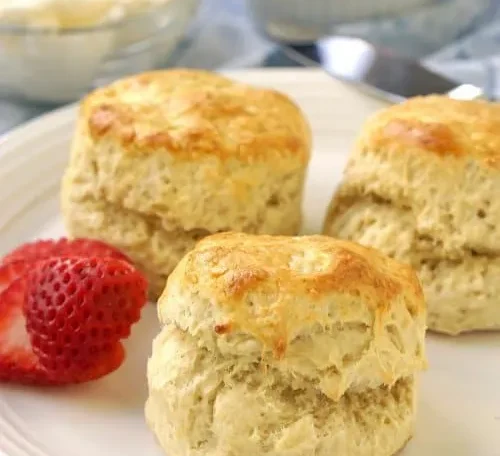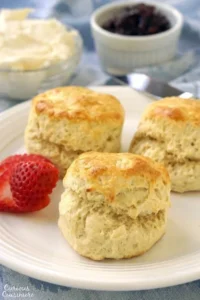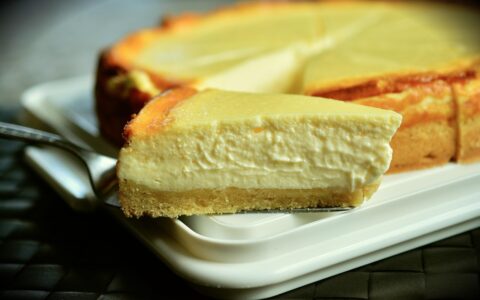
Win Your Next Pageant
Thank you for reading this post, don't forget to subscribe!Get Pageant Questions Written By A Miss Universe Judge

The Timeless Charm of British Scones: A Bite-Sized History of Afternoon Tea’s Star
Few baked goods embody the cozy elegance of British teatime quite like the humble scone. With its golden crust, feather-light crumb, and ability to spark lively debate (cream or jam first?), this unassuming pastry has risen from Scottish hearths to royal tea tables over centuries. More than just a quick bread, the scone represents a fascinating intersection of culinary simplicity, social ritual, and regional pride that continues to evolve while honoring tradition.
From Scottish Griddle to Victorian Tea Table: A Scone’s Journey
The scone’s story begins not in dainty tearooms, but in the rugged kitchens of medieval Scotland. Historians trace its origins to:
- Early 1500s: The first written mention of “scone” (from the Dutch schoonbrot, meaning “fine bread”) as a round, flatbread baked on griddles
- 1740s: Scottish poet Robert Burns references “tea and scones” in correspondence, signaling its shift from savory oatcake to sweetened teatime treat
- 1840s: The Duchess of Bedford popularized afternoon tea in England, cementing scones as an essential component of the ritual
Early versions bore little resemblance to today’s fluffy creations. Made with oats and cooked on stovetops, they were split like bread rather than cut. The modern scone emerged with:
- The spread of baking powder (1840s), creating lighter textures
- Wheat flour replacing oats as milling technology improved
- The cream tea tradition of Devon and Cornwall, which sparked the great “cream first” debate
The Science of the Perfect Rise: Why Technique Matters
What separates a tender, lofty scone from a dense hockey puck? The magic lies in precision:
1. Cold Chemistry
- Chilled butter creates steam pockets during baking = flaky layers
- Minimal handling prevents gluten development = tender crumb
- Fresh baking powder ensures proper lift (test it by mixing 1 tsp with hot water—it should bubble vigorously)
2. Moisture Balance
- Whole milk or buttermilk adds fat for richness while controlling gluten
- Egg (uncommon in traditional recipes) modernizes texture for a cakier bite
3. Heat Dynamics
- High oven temp (400°F/200°C) sets the structure quickly for maximum rise
- Even spacing on the baking sheet allows for proper airflow
Cultural Icon: More Than Just a Baked Good
The scone has become embedded in British identity through:
Regional Rivalries
- Devon vs. Cornwall: The “cream tea wars” over whether jam or clotted cream should be applied first (Devon: cream first; Cornwall: jam first)
- Scottish vs. English: Scots insist on griddle-baked “dropped scones,” while English favor oven-baked rounds
Social Rituals
- Afternoon tea’s “scone course” served between sandwiches and pastries
- The proper etiquette debate: splitting with hands vs. cutting with a knife
Global Adaptations
- America: Often oversized, triangular, and sweet (like Starbucks’ blueberry scones)
- Australia: “Pumpkin scones” as a national favorite
- Japan: Matcha or sakura-flavored scones served with wagashi
Modern Twists on Tradition
While purists champion plain or fruit scones, contemporary bakers experiment with:
- Savory versions: Cheese & chive, bacon & maple
- Dietary adaptations: Gluten-free, vegan, or keto almond flour scones
- Global flavors: Cardamom, ube, or chai-spiced
Yet even with innovations, the core appeal remains—a warm, buttery vehicle for clotted cream and jam that transports eaters to cozy tearooms with every bite.
Why Scones Still Captivate
Beyond taste, scones endure because they represent:
- Nostalgia: Memories of grandmothers’ baking or holiday teas
- Accessibility: Simple enough for beginners yet technical enough to challenge bakers
- Versatility: Equally at home in a lunchbox or at a Buckingham Palace garden party
Ready to Bake?
Whether you’re team cream-first or jam-first, mastering the classic scone connects you to centuries of culinary tradition. Follow our recipe to experience why this humble pastry remains teatime’s crowning glory—one perfectly crumbly, cloud-light bite at a time.
Fun Fact: The world’s largest scone weighed 252 lbs (114 kg) and was made in Devon in 2017! Will yours be next? 🇬🇧🍽️
Equipment Needed (Amazon Deals, Buy Now, Click On Link Below)
- Food Processor
- Stand Mixer (with Dough Hook)
- Saucepan or Skillet – for browning the butter
- Mixing Bowls – at least two: one for wet ingredients, one for dry
- Electric Mixer – stand or handheld (optional, but helpful for creaming)
- Spatula – for stirring and scraping
- Whisk – to blend dry ingredients
- Measuring Cups and Spoons – for accuracy
- Baking Sheet(s) – for baking the cookies
- Parchment Paper or Silicone Baking Mat – prevents sticking
- Cooling Rack – to cool the cookies evenly
- Knife and Cutting Board – for chopping pecans
Optional but Helpful:
-
Cookie Scoop – for evenly-sized cookies
-
Fine Mesh Strainer or Sifter – for sifting dry ingredients (if needed)
-
Storage Container – for keeping cookies fresh
Classic British Scones Recipe
Light, flaky, and perfect with clotted cream & jam for afternoon tea!
Prep Time: 15 mins
Cook Time: 12-15 mins
Servings: 8 scones
Ingredients
- 2 cups (250g) all-purpose flour (plus extra for dusting)
- 1 tbsp baking powder
- ¼ tsp salt
- ¼ cup (50g) granulated sugar
- ½ cup (115g) cold unsalted butter, cubed
- ½ cup (120ml) whole milk (plus 1 tbsp for brushing)
- 1 large egg
- 1 tsp vanilla extract (optional)
For Serving:
- Clotted cream or whipped cream
- Strawberry jam
- Fresh berries
Instructions
1. Prep & Mix Dry Ingredients
- Preheat oven to 400°F (200°C). Line a baking sheet with parchment.
- In a large bowl, whisk together flour, baking powder, salt, and sugar.
2. Cut in Butter
- Add cold butter. Use a pastry cutter or fingers to rub into flour until it resembles coarse crumbs.
3. Add Wet Ingredients
- In a small bowl, whisk milk, egg, and vanilla.
- Make a well in dry ingredients; pour in wet mix. Gently stir until just combined (don’t overwork!).
4. Shape & Cut
- Turn dough onto a floured surface. Pat into a 1-inch (2.5cm) thick circle.
- Use a 2.5-inch (6cm) round cutter to cut scones (don’t twist—press straight down).
5. Bake
- Place on baking sheet, brush tops with milk.
- Bake for 12-15 mins until golden. Cool slightly before serving.
Pro Tips
✔ Keep ingredients cold for flaky layers.
✔ Handle dough minimally to avoid toughness.
✔ Serve warm with clotted cream & jam for authentic cream tea.
Store in an airtight container for 2 days or freeze unbaked dough!
Variations:
- Cheese Scones: Omit sugar, add ½ cup grated cheddar + 1 tsp mustard powder.
- Fruit Scones: Fold in ½ cup raisins or currants.
- Vegan: Use plant-based butter + almond milk.
Enjoy with a cuppa! ☕🇬🇧



 Subscribe to Our RSS Feed
Subscribe to Our RSS Feed



